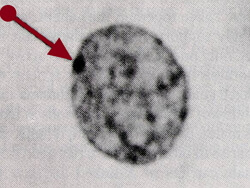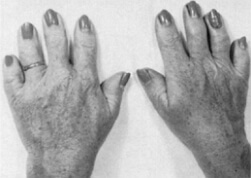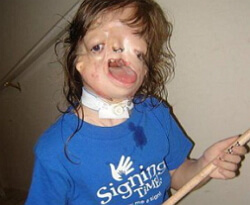Cretinism
 Cretinism is a kind of one of the pathologies of the endocrine system, which is associated with a violation of the adequate functioning of the thyroid gland, which is usually a congenital anomaly. Cretinism is characterized by dementia, as well as abnormalities and lagging behind physical and / or mental development. The disease is observed by the type of endemia and certain outbreaks.
Cretinism is a kind of one of the pathologies of the endocrine system, which is associated with a violation of the adequate functioning of the thyroid gland, which is usually a congenital anomaly. Cretinism is characterized by dementia, as well as abnormalities and lagging behind physical and / or mental development. The disease is observed by the type of endemia and certain outbreaks.
Cretinism is endemic in different parts of the planet, but usually in mountainous areas. For example: the Pyrenees, the Caucasus, the Alps, the Altai, etc. The disease is manifested by a combination of dementia with goiter and certain physical anomalies of a different nature. In the valleys of Savoy, Switzerland, Carinthia and in several other areas, sometimes even not mountainous, there are settlements where the majority of the population suffers from iodine deficiency. Of these, some part does not represent mental underdevelopment, and the other part, on the contrary, represents significant signs of cretinism.
Cretinism causes
Cretinism is classified as a thyroid gland and the main reason for its appearance is a deficiency of thyroid hormones and a decrease in its functions. This causes a delay in the mental and physical development of a person.
The main reason for the appearance of congenital cretinism is, of course, the lack of iodine in the body of a pregnant woman. During the period of gestation, the woman should receive a double dose of iodine, which is necessary for the normal functioning of the thyroid gland. If she lives in a certain area where there is a lack of iodine and can not make up for it with food( hypovitaminosis, inadequate or unbalanced nutrition), the fetus may also suffer from iodine deficiency. Therefore, cretinism in children is also often accompanied by a lack of iodine and disrupted work of the endocrine system.
Also, autoimmune diseases in the pregnant and fetus, in addition to disrupting the development of the thyroid gland, in the embryonic period are considered the cause of cretinism in children. The fetus may have such a pathology as the absence of the thyroid gland. As a rule, such children are born critically of small weight and height with obvious signs and developmental disorders. Their life, as a rule, is short-lived. But such cases are rare, because even in the womb with the help of ultrasound therapy one can suspect violations in the development of the fetus. Also, the surrender of pregnant blood to the pathology of the fetus will help to suspect that something is wrong with its development with such an anomaly as the absence of the thyroid gland, because the entire hormonal background of the fetus depends on the endocrine system.
Hypoplasia and ectopia of the thyroid gland can also be a cause of cretinism. If the pregnant woman during the bearing of the child receives therapy with thyreostatic medicines, this can not but affect the development of the fetus. Endemic goiter is manifested with the slow development of cretinism, especially cretinism in children. In no case can ignore the lag in the development of the child, especially during the visit to the kindergarten and primary school.
It is also believed that marriage between close relatives provokes a pathology in the development of the fetus as cretinism.
It has been established that the severity of cretinism depends on the amount of iodine consumed with food. There are data on specific populations that have a persistent tendency of childbearing with congenital hypothyroidism. Because it is officially established that the prevalence of cretinism is found in most cases in those areas where there is a shortage of iodine in food.
Cretinism symptoms
In a macroscopic picture, asymmetry and microcephaly of the brain, a small amount of convolutions, a thickening of the soft and hard meninges are revealed. The cavities of the cerebral ventricles are somewhat enlarged and filled with liquid, the ependyma is thickened. The weight of the brain is changed.
The microscopic picture of the brain with cretinism is mostly unknown. Often there are chronic changes in the degenerative type of cells in the ganglia. There are no definite histological changes in the thyroid gland. Often, degenerative and atrophic processes in the parenchyma of the gland and the growth of its connective tissue are revealed.
Signs of cretinism appear in the form of facial abnormalities and growth disorders that affect both bones of the skeleton and soft tissue. Growth disorders are especially pronounced in cretins without manifestations of goiter - they have dwarf growth;But in goiter in cretins, in most cases, a fairly sharp lag in growth is observed. Cramps are born normal growth, but because of the belated closure of seams( epiphyseal), their growth continues up to 25-30 years.
The x-ray reveals a delay in ossification: the later appearance of the ossicles on the upper limbs and the belated closure of the cranial and epiphyseal sutures. If we talk about the proportions of the body, then only in a quarter of cases the correct proportions and the structure of the bones take place. But, at other times, the body has an awkward appearance and wrong proportions, because not all affected bones have the same degree of growth, they are wrong;Extremities in relation to the body are most lagging behind in development: they are massive, short, joints thickened, twisted, bones of arms wide, and feet turned inwards.
Bones of cretins differ in excessive hardness;Of other skeletal errors, ankylosis, pelvic narrowing, scoliosis, flattening and shortening of the femoral head can be noted.
Pathologies in the structure of the face to the proportions of the skeleton have a characteristic reflection in the anatomy of the nose. Because of the general delay in the growth of the bones, the skull base becomes shorter, which causes the nasal root not to protrude forward, but remains flattened and sunken, and is also called the saddle nose.
The distance between the corners of the( internal) slits of the eye is greater than the distance in the norm. Nose wide, short, with broad nostrils, flattened. The front part has a width that is much higher than the height, and there is also an asymmetry.
The cerebral part of the skull also differs by a small or larger size. The weight of the brain in relation to the growth retardation is large. Eyelids, lips, cheeks and forehead are edematous and puffy. The face has rounded forms.
The skin is pale, thick, dry, resembling the effects of myxedema. The same skin is often observed on the face, hands and hips. The feet and brushes are thickened in the form of pads. On the forehead there are transverse folds, which give the face a senile appearance.
Hair on the body is scanty. The hair is bristly, coarse, dark in color, the nails are brittle and brittle. If you add to this the low forehead position, large lips and mouth, sticking out tongue, lop-eared, sharply protruding cheekbones, drooling, you can get an explicit prototype of a cretin.
Also the signs of cretinism are: chronic conjunctivitis, which develops as a result of an impaired flow of tear fluid due to the pathological configuration of the nose, short neck, round abdomen, umbilical hernia, forward posture bent forward. The goiter does not happen to all people with cretinism, but still, the percentage of its availability is greater than the absence.
Goiter with cretinism can reach gigantic proportions. It can be hard or soft in consistency. Atrophic and sclerosing processes are detected in the thyroid gland. Sexual glands with cretinism also have irregularities in their work. They reveal signs of atrophy. Internal and external genital organs with cretinism are poorly developed: the penis is small in size, small testicles, often there is cryptorchidism( in males);Uterus of infantile size, cystic-degenerated ovaries, later onset of menstruation of lean character, flabby mammary glands( in females).Women with cretinism are infertile, or have a high percentage of premature births and stillbirths. Rarely does a child have such a full-fledged mother.
Signs of cretinism are also considered violations in the work of the heart. The large size of goiter can lead to stagnation of blood circulation in a small circle, which leads to insufficiency and expansion of the heart. The clinical picture of blood is not stable. Often, anemia is detected: the number of blood cells and hemoglobin is lowered. Platelets are increased. The content of iodine in the blood averages 0.003 mg per 100 ml of blood instead of 13 mg, which is low. The metabolism is reduced. Urination is decreased, often a delay in salt and protein metabolism is observed. A characteristic phenomenon is a low content of iodine in the thyroid gland, but with an optimal amount of urine.
Patients also have chronic constipation. Cretans suffer from hearing loss in almost half the cases, less common is deaf mute. The decrease in auditory conductivity is associated with a disruption in the structure of the labyrinth in the middle ear, and this may also be due to the process of degeneration and lag in the development of acoustic cortical centers.
With regard to vision, with cretinism, strabismus is a frequent phenomenon, and a narrowing of the visual field is somewhat less common;Sense of touch and smell reduced.
The cretins have a loose and clumsy gait. Children begin to make confident steps only to five years. In severe cases, they generally can hardly move and crawl;It is also associated with bone pathology and muscle weakness, but the role of neural coordination plays a significant role here.
Clear signs of cretinism are mental disorders, ranging from different forms of dementia, for example, idiocy, ending with mild debility.
Sometimes there are no pathologies in mental development at all, but due to poorly developed hearing and speech, an illusion of dementia can be created.
Whatever the stage of dementia in nerds is, its course is always torpid;Rarely there may be anxiety and erection. Therefore, with cretinism, children do not learn well, often without mastering the material they have covered. In cretins memory is mostly of a mechanical nature. It is preserved, but sometimes there is hypermemia. In severe cases of cretinism, speech is severely impaired: patients produce inarticulate sounds in which their emotions are expressed. Many patients stutter and lisped.
Generally, emotional excitability in cretins is negligible. The mood is usually apathetic or phlegmatic. For the most part, the patients are good-natured, affectionate and show strong attachment to their family. At the same time they are rather shy and touchy. Attacks of anger at them quickly enough pass or take place. Sexual desire or libido in them is reduced or absent altogether. But it is worth remembering that for one reason only, it is very difficult to diagnose cretinism.
Cretinism treatment
The course of cretinism has a chronic character. In some cases, there may be an improvement or deterioration( because of the transferred bacterial infections).Creti rarely live more than 30-40 years, but by the age of 30, in most patients, goiter becomes smaller in size, the form of puffiness decreases. Their behavior becomes somewhat more lively.
Treatment of cretinism with drugs for the thyroid gland is performed in cases of early diagnosis of the disease, in other cases such therapy is practically ineffective. A much greater effect can be achieved when signs of cretinism show themselves later. The appointment of drugs with cretinism has long been established in the form of Levothyroxine and Triiodothyronine. These medications are referred to as thyroid hormones. They make up for the lack of thyroid hormones. Thyreoidin is prescribed at the initial dose, depending on the age, for adults by 0.1 g for 3 r.in a day;Children from 1 year to 2 mg 3 r.in a day;Children from 2 years to 5 mg three times a day with a gradual increase in the dose of 1 mg. After a week of treatment, the dose is increased by 10-20 mg per day. After 2 months from the beginning of therapy, treatment is prescribed with the introduction of the optimal dosage from 0.1 g per day. It is important to monitor the patient's condition. Cretinism in children is accompanied by the appointment of iodine preparations. All patients should receive a balanced diet.
The main prevention of this disease is a sufficient intake of iodine during pregnancy. Purpose of preventive dosages of iodine and vitamin D preparations in children. Vitamin D well prevents the condition of rickets and strengthens the musculoskeletal corset of the skeleton. In addition, it is important in infancy to breast-feed children, which is considered not only the prevention of endemic goiter and, as a result, cretinism, but also the prevention of most diseases.



